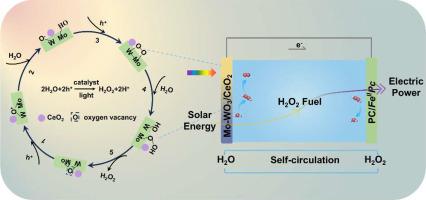S-scheme Mo-WO3/CeO2 microspheres photoanode enabling high-efficiency power generation in H2O2 photoelectrochemical cell
IF 14.3
1区 材料科学
Q1 MATERIALS SCIENCE, MULTIDISCIPLINARY
引用次数: 0
Abstract
This study introduces a significant advancement in sustainable energy conversion through a novel hydrogen peroxide (H2O2) photoelectrochemical cell system. By integrating an oxygen vacancy-rich Mo-doped WO3 (Mo-WO3)/CeO2 S-scheme heterojunction photoanode with a cornstalk-derived porous carbon/Fe-phthalocyanine (PC/FeIIPc) cathode, the system achieves efficient solar-driven H2O2 production and direct electricity generation via in situ H2O2 fuel utilization. The Mo-WO3/CeO2 heterojunction synergizes with Mo doping-induced oxygen vacancies (OVs) and S-scheme charge transfer pathways, significantly enhancing light absorption and charge separation. This design enables a remarkable H2O2 yield of 0.044 M and a maximum power density of 5.79 mW cm−2, surpassing the pristine WO3-based cell by 4 and 2.55 times, respectively. Additionally, the cell exhibits robust dark-phase energy storage with a capacitance of 57834 mF cm−2, which has a 54% capacity retention over 12 h. Combined experimental and theoretical analyses reveal that oxygen vacancies in Mo-WO3 act as electron traps, while the S-scheme heterojunction’s internal electric field directs charge flow, collectively suppressing recombination and preserving redox potentials. This work establishes a green paradigm for simultaneous solar energy harvesting, chemical fuel storage, and on-demand electricity generation.

s方案Mo-WO3/CeO2微球光阳极实现H2O2光电电化学电池的高效发电
本研究介绍了一种新型过氧化氢(H2O2)光电电化学电池系统在可持续能源转换方面的重大进展。通过将富氧空位的mo掺杂WO3 (Mo-WO3)/CeO2 s方案异质结光阳极与玉米秸秆衍生的多孔碳/ fe -酞菁(PC/FeIIPc)阴极集成,该系统实现了高效的太阳能驱动H2O2生产和通过原位H2O2燃料利用直接发电。Mo- wo3 /CeO2异质结与Mo掺杂诱导的氧空位(OVs)和S-scheme电荷转移途径协同作用,显著增强了光吸收和电荷分离。该设计实现了0.044 M的H2O2产率和5.79 mW cm - 2的最大功率密度,分别是原始wo3基电池的4倍和2.55倍。此外,该电池表现出强大的暗相储能能力,其电容为57834 mF cm−2,在12小时内保持54%的容量。实验和理论分析表明,Mo-WO3中的氧空位充当电子陷阱,而S-scheme异质结的内部电场引导电荷流动,共同抑制重组并保持氧化还原电位。这项工作建立了同时收集太阳能、化学燃料储存和按需发电的绿色范例。
本文章由计算机程序翻译,如有差异,请以英文原文为准。
求助全文
约1分钟内获得全文
求助全文
来源期刊

Journal of Materials Science & Technology
工程技术-材料科学:综合
CiteScore
20.00
自引率
11.00%
发文量
995
审稿时长
13 days
期刊介绍:
Journal of Materials Science & Technology strives to promote global collaboration in the field of materials science and technology. It primarily publishes original research papers, invited review articles, letters, research notes, and summaries of scientific achievements. The journal covers a wide range of materials science and technology topics, including metallic materials, inorganic nonmetallic materials, and composite materials.
 求助内容:
求助内容: 应助结果提醒方式:
应助结果提醒方式:


